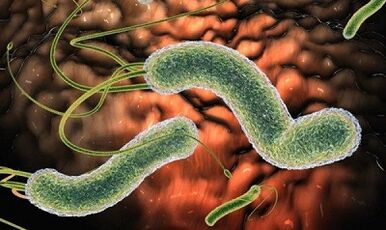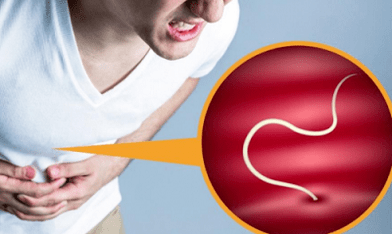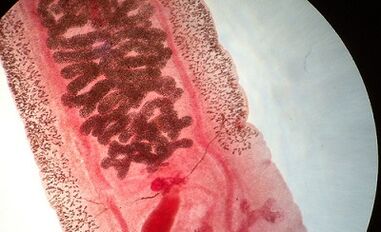
Among patients, a serious misconception is that helminths live only in the intestines.However, one cannot deny the fact that parasites in human blood are as widely wide as other types of helminthias.The identification and timely therapy of such pathological states require special attention, since when it gets into the bloodstream, a small socket can hit absolutely any organ.
Symptoms and painful sensations that cause worms in the blood in humans can be different both in manifestations and the degree of their severity.It is important to start treatment in a timely manner and prevent the further spread of parasites on the human body in order to prevent complex consequences in a timely manner.Initially, it is necessary to find out how worms appear in the blood.
Types of parasites setting the bloodstream
Nothing is so much complicated by the production of the correct differential diagnosis as a huge spread of the symptoms that manifest in patients with parasites in the blood.Various types of helminths cause different signs.In case of worms infection with blood or blood vessels, the patient needs to undergo a complete medical examination that will help to identify the type of parasite and determine the adequate treatment of the pathological condition.
There are a number of parasites that are able to live in human blood:
- Babesia;
- malaria plasmodium;
- Tripanosoma;
- ankylostoma;
- Trichinella;
- toxoplasma;
- TOKSOKARA.
Most helminths enter the human body after an insect bite.Such parasites of the circulatory channel are most dangerous for children.They affect the proper development of organs, the growth of the whole organism and the state of the immune system.Many people can live with parasites for years and not even suspect that they are infected.
General symptoms of parasitic blood poisoning
Each individual type of parasites in the human blood has symptoms that are characteristic only for this disease.
However, there are a number of signs characteristic of any type of helminthosis:
- weakness;
- dizziness, headache;
- nausea, vomiting;
- it is possible to increase the total body temperature;
- aches in the limbs and all the body;
- Attacks of loss of consciousness are possible.
All these symptoms are the main manifestations of the increased content of toxic substances in the body.At the first their appearance, it is necessary to contact a medical institution where doctors will conduct all the necessary tests and diagnostic procedures, which will most accurately determine the cause of such a state.
Babesiosis: symptoms, diagnosis and treatment
Babesia are small parasites that enter the human body after a bite of an ixodic tick.These simplest organisms quickly penetrate the erythrocyte membrane inside and begin their difficult life cycle.The disease is widely used in warm regions where mites of the Ixodes clan live.
In most cases, the disease proceeds without obvious symptoms in both adults and in children.
However, when the disease appears and is further developed, the characteristic features are noted:
- hemolytic anemia;
- fever to 39-40 degrees;
- chills;
- increased sweating.
Similar symptoms appear no later than 4 weeks after the bite of the tick.After the incubation period, the chances of identifying the disease are much higher.
The disease can only be diagnosed in the conditions of specialized laboratories.For this reason, there is not so much data on the spread of the disease and its symptoms.
However, the attending physician should take a number of measures to identify pathogenic alien agents in the patient's body:
- general blood test;
- Serological tests for antibodies to women;
- polymerase chain reaction;
- Microscopic examination of the blood smear (staining by hymse).
Treatment is carried out mainly with antiprotozoal drugs.Typically, the course of taking such funds lasts no more than 10 days, but can continue in patients with a recurrent form of the disease.Treatment of asymptomatic patients is carried out only when the causative agent of Babusiosis is detected in the blood during re -analysis, which is carried out a few months after the initial detection, when the attending disease was recurrent.
Tripanosomosis: symptoms, diagnosis, treatment

Tripanosomosis, or so -called sleepy disease, is widespread in countries in tropical and subtropical climate and is rarely found in temperate latitudes.The causative agent of the disease is a tripanosome.This is a small parasite.Having looked at the photo of the parasite made using an electron microscope, you can distinguish flagella and a membrane along the entire length of the simplest body.
The disease and its symptoms develop in two full stages.At the first stage, the parasite penetrates into human red blood cells and begins its active reproduction.
This stage can be recognized by the following signs:
- bouts of fever up to 7 days;
- headaches, weakness;
- joint pain and limbs;
- severe itching;
- The appearance of red chacks in the site of inflamed lymph nodes.
In the second stage of the disease, the tripanosome penetrates the central nervous system through the hematoencephalic barrier.This stage is characterized by serious impaired sleep and wakefulness cycle - the main symptom of the disease.
In addition, in the patient in the second stage of sleepy illness may appear:
- blurred consciousness;
- muscle trembling, weakness;
- paralyzed limbs;
- apathy;
- irritability;
- Aggression in relation to others.
It is necessary to start treatment as soon as possible, otherwise it is not the most favorable outcome.Progressing, the disease leads to the appearance of organ failure of several body systems at once, the consequence of which is the death of the patient.
Diagnosis of sleepy disease is based on the symptoms of the patient and microbiological studies for the presence of tripanos in the blood, lymph and purulent fluid taken from Shancra.With positive samples, treatment is urgently prescribed.
A good prognosis can be made when the disease can be detected at the hemolytic stage.At this time, quite toxic drugs are prescribed, but in general, the treatment is well tolerated by the patient's body.
However, when the disease manages to recognize only at the second stage, the prognosis is not always comforting.To treat such a pathological condition, it is necessary to use serious, toxic drugs that can penetrate through the protective barrier of the central nervous system.
Malaria: symptoms and treatment

Infection with malarial plasmodium occurs through a mosquito bite.Through the salivary glands of the females, the parasite penetrates into the bloodstream of a person, is transferred with a blood flow into the liver, where the first stages of metamorphosis passes, and then again enters the bloodstream and affects red blood cells.
The incubation period of the disease lasts up to 25 days.Then the first symptoms of malaria are manifested:
- a sharp increase in body temperature;
- headache, weakness;
- hemolytic anemia;
- yellowness of the skin;
- nausea, vomiting;
- soreness of the joints, aches throughout the body;
- bouts of convulsions;
- The emergence of products of the destruction of red blood cells in the urine.
Basically, the disease is widespread in warm and hot regions, so its diagnosis is based only on the symptoms and history of the patient’s life that manifested over time.Frequent travel to equatorial countries can cause the development of the disease.In addition, standard blood tests and a microbiological examination of the body fluids are carried out.
Therapy is prescribed depending on the type of disease and its severity and is carried out mainly using antimalarial drugs.
Ankylostomosis: symptoms, diagnosis and treatment
The parasites causing the disease live in the genes of the intestines and feed on the blood cells of the master's body.Worms penetrate through the skin of a person and begin migration into the intestines.In the process of moving around the body, parasites with blood flow fall into the lungs, then pass along the bronchi in the trachea and the upper respiratory tract, where they provoke a swallowing reflex, and thus reach the intestines, on the walls of which are fixed.
In rare cases, worms of worms are not able to successfully complete their migration and remain under the skin of a person.In the photo, a similar process resembles small, thin snakes under the skin of the patient.

Eating blood, worms provoke the development of iron deficiency anemia in an infected person.The most dangerous when worms penetrate the children's body.The lack of iron, protein and other necessary components for the development of a child can cause mental retardation, growth retardation and physical inferiority.
The main symptoms of ankylostomosis:
- iron deficiency anemia;
- bouts of fever;
- pain in the abdomen;
- nausea, vomiting;
- diarrhea, constipation;
- severe loss of body weight;
- Coughing, infectious diseases of the upper respiratory tract during the migration of the larval stages of the parasite are possible.
Among the diagnostic measures, a general blood test, the analysis of feces and urine, an ultrasound examination of the digestive system are distinguished.The identification of parasites becomes a good reason to begin immediate treatment and prevention of pathological conditions associated with impaired functioning of the respiratory, digestive and circulatory systems of the patient's body.
Treatment is carried out by a one -time intake of the anthelmintic drug.Therapy is supplemented with the use of vitamin and mineral complexes, allowing to smooth out the consequences of hemoglobin deficiency.
Toxocarosis: symptoms and treatment
The causative agents of this disease are round helminths, which a person can get after prolonged communication with pets who have not passed deworming, when eating unwashed vegetables and fruits.The human body becomes an intermediate host of the parasite.
Getting into the intestines, larvae hatch from eggs and begin to “drill” the intestinal wall, penetrating into the bloodstream.With blood flow, helminths migrate into any system of the human body.The result of the migration of worms is serious impaired liver, heart, central nervous system and organs of vision.

The main symptoms of infection of the body toxocracles:
- increasing the total body temperature;
- the appearance of severe pain in the abdomen;
- weakness, dizziness;
- the appearance of an allergic rash on the skin;
- strong cough at night;
- Convulsions, muscles and joint pain.
Diagnosis of the disease is quite difficult.It is necessary to conduct serious microbiological, allergological tests for which a specialized laboratory is needed:
- polymerase chain reaction;
- immunosorbent analysis;
- Serological tests;
- ultrasound examination of organs;
- Magnetic resonance and computed tomography.
Serious anthelmintic therapy is carried out only when severe damage to the brain is detected, the patient's heart muscle.Very often the disease passes independently, since the larval stage cannot develop into an adult individual in the body of an intermediate host.
However, it is necessary to take into account the harm that migrating worms can cause the patient.It is necessary to carry out supportive therapy and take the necessary measures to prevent the development of serious pathological processes in the liver, cardiovascular and other organs.
Conclusion
Any parasites are dangerous for the human body.If questions arise, “what parasites live or use blood as a transport system”, “how to determine it correctly or not”, “how to treat them and what to take”, then it is best to contact a parasitologist, and not make independent decisions.Treatment and prevention of parasitic diseases is a decision that a qualified doctor should take.



























